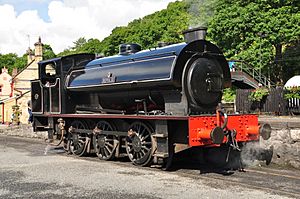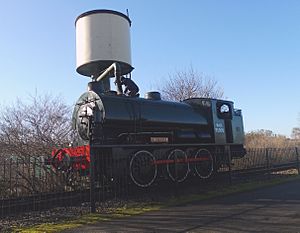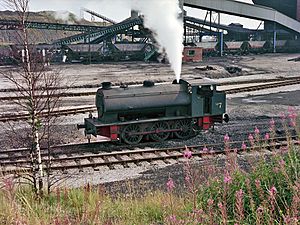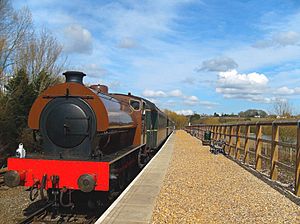Hunslet Austerity 0-6-0ST facts for kids
Quick facts for kids Hunslet Austerity 0-6-0ST |
|
 |
|
| Austerity No. 3698 Repulse at the Lakeside and Haverthwaite Railway | |
| Power type | Steam |
|---|---|
| Designer | Hunslet Engine Company |
| Builder | Hunslet Engine Company, Andrew Barclay Sons & Co. (15), W. G. Bagnall (52), Hudswell Clarke (50), Robert Stephenson and Hawthorns (90), Vulcan Foundry (50) |
| Build date | 1943–1964 |
| Total production | 485 |
| Configuration | 0-6-0ST |
| UIC classification | Cn t |
| Gauge | 4 ft 8 1⁄2 in (1,435 mm) standard gauge |
| Driver diameter | 4 ft 3 in (1.295 m) |
| Minimum curve | 180 ft (54.86 m) |
| Wheelbase | 11 ft 0 in (3.35 m) |
| Length | 30 ft 4 in (9.25 m) |
| Axle load | 13 long tons 7 cwt (29,900 lb or 13.6 t) |
| Locomotive weight | 48 long tons 5 cwt (108,100 lb or 49 t) |
| Fuel type | Coal |
| Fuel capacity | 2 long tons 5 cwt (5,000 lb or 2.3 t) |
| Water capacity | 1,200 imp gal (5,500 L; 1,400 US gal) |
| Boiler | Round top outer firebox, 181 tubes, copper or steel inner firebox |
| Boiler pressure | 170 psi (1.17 MPa) |
| Fire grate area | 16.8 sq ft (1.56 m2) |
| Heating surface: Tubes | 873 sq ft (81.1 m2) |
| Heating surface: Firebox | 88 sq ft (8.2 m2) |
| Superheater type | None |
| Cylinders | Two, inside |
| Cylinder size | 18 in × 26 in (457 mm × 660 mm) |
| Valve gear | Stephenson |
| Valve type | Slide valves |
| Tractive effort | 23,870 lbf (106.18 kN) |
| Power class | BR: 4F |
| Nicknames | Austerity |
| Retired | 1959–1984 |
| Disposition | 70 preserved, remainder scrapped |
The Hunslet Austerity 0-6-0ST is a special type of steam locomotive. It was designed by the Hunslet Engine Company to move train cars around in busy places. This powerful little engine became the main type of shunting locomotive used in Britain during the Second World War. They were built for a long time, from 1943 all the way until 1964!
Contents
Why the Austerity Engine Was Built
Before the Austerity, there was a similar engine called the 48150 class. It was made in 1937 for a steel company. This design was then improved into the 50550 class in 1941.
When the Second World War began, the War Department needed many shunting locomotives. They first thought about using a different engine. But Hunslet suggested their new, simpler 50550 design. It was perfect for wartime needs. The very first Austerity locomotive was finished in early 1943.
Building the Austerity Locomotives
Hunslet needed to build many engines quickly. So, they asked other companies to help. These companies included Andrew Barclay Sons & Co., W. G. Bagnall, Hudswell Clarke, Robert Stephenson and Hawthorns, and the Vulcan Foundry.
After D-Day in 1944, these engines were used in Continental Europe and North Africa. They also worked at docks and military bases in Britain.
By 1947, 377 Austerity engines had been built for the War Department. Two more were built for coal mines without official permission. When the war ended, fewer locomotives were needed. The military decided what to do with their engines:
- 90 locomotives were kept by the military for their own railways.
- 75 were sold to the LNER. They were called the J94 class.
- 27 engines that had been used in the Netherlands were sold to the Nederlandse Spoorwegen railway company. They became the NS 8800 class.
- 11 were loaned to another Dutch company, and 9 of these were later bought.
Many other Austerity engines were sold for industrial use. Some went to light railways in France. Six even went to the Chemins de Fer Tunisiens in 1946. One was used at the Peugeot car factory in France.
More Austerity Engines Are Built
Even as the last wartime engines were delivered, new orders came in. The National Coal Board (NCB) wanted more Austerity locomotives for their coal mines. Between 1948 and 1964, 77 new Austerity engines were built for the NCB. The British Army also ordered 14 more engines in 1952.
The Yorkshire Engine Company also built eight of these engines in 1954. They were used in ironstone quarries and at the Scunthorpe Steelworks.
Hunslet also rebuilt many NCB locomotives. When the Army started selling off engines again in 1959, Hunslet bought 15 of them. They rebuilt these engines and sold them. The NCB bought 13 of them. One was sold directly to a railway museum. The last one was scrapped. In total, 485 Austerity engines were built between 1943 and 1964.
The NCB continued to use Austerity engines into the 1970s. A few even stayed in service until the early 1980s. This was especially true at Bickershaw Colliery in Greater Manchester. Some of the longest-lasting engines had special features. These included mechanical stokers and special blast pipes. These features helped them work better and produce less smoke.
Austerity Engines Today: Preservation

Seventy Austerity engines have been saved and are now on heritage railways. Many of them are still working! People sometimes call them 'Buckets'. Some have been painted to look like the LNER Class J94 engines. This helps them look more like mainline railway engines. In 1979, during the "Rocket 150" celebration, an Austerity engine named Robert was part of a special parade of locomotives.
Not all preserved Austerity engines are exactly as they were. For example, the boiler from one Austerity was used to build a replica of the famous Iron Duke locomotive in 1985. Another Austerity engine at the Watercress Line was even changed to look like Thomas the Tank Engine. Another one was made to look like Douglas, also from The Railway Series books.
Austerity Models and Toys
The Hunslet "Austerity" engine has been popular for models and toys. Kitmaster first made a model kit of it in 1961. This was for the popular 00 gauge size. The Kitmaster tools were later sold to Airfix in 1962. Then, in 1981, they went to Dapol. Dapol kept making the models until their factory had a fire in 1994.
Dapol also made ready-to-run models of these locomotives. In 1996, these tools were sold to Hornby. Hornby still makes the "Austerity" model today. You can find it as the J94 class or in different industrial colours.
Graham Farish and later Bachmann have also made "Austerity" models. These are for the smaller N gauge size. They are sold as the LNER/BR J94 class.
DJmodels also made J94 and Austerity tank engine models in 00 gauge. They came in many different colours, including BR and industrial ones. This model is now part of the EFE Rail range.



